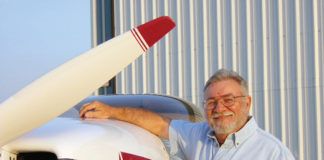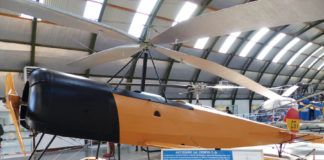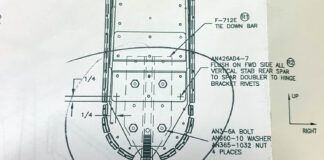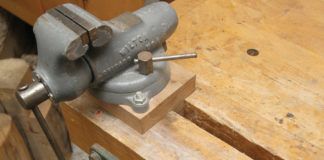In the last few installments of this column, we have explored single-axis lateral and directional motions and maneuvers. In real life, the lateral and directional motions of airplanes are almost always coupled. The airplane rarely yaws without rolling or rolls without yawing. We will examine three examples of coupled lateral/directional motion: adverse yaw, the spiral mode and Dutch roll.
Adverse Yaw
When a pilot pushes the stick laterally and deflects the ailerons, it is an attempt to command a pure rolling motion of the airplane. Unfortunately, the aerodynamics are uncooperative. Deflecting the ailerons will often cause the airplane to yaw as well as roll. For most airplanes, this yaw is in a sense opposite to that of the roll. In other words, if the stick is pushed to the left, the airplane will roll left wing down and yaw nose right. This phenomenon is called adverse yaw because the airplane is yawing the wrong way.
Adverse yaw is caused by a combination of effects. First, deflecting a plain-flap aileron down increases parasite drag more than deflecting the same aileron up an equal amount. Accordingly, if the ailerons are deflected equal and opposite amounts, the parasite drag of the wing with the down-deflected aileron will be higher than that of the wing with the up-deflected aileron.
The second effect contributing to adverse yaw is the change in induced drag between the two wings. The ailerons increase the lift of the wing the pilot wishes to raise, and decrease the lift of the opposite wing. The lift increase on the rising wing also increases its induced drag, while decreasing induced drag on the descending wing. This induced drag difference occurs even when the mechanism for changing lift is not ailerons. The Wright brothers encountered adverse yaw on their early gliders, which had wing warping for lateral control. It was adverse yaw that led them to put a moveable rudder, geared to move simultaneously with the wing warp, on their powered flyer.
Induced drag is proportional to the square of the lift coefficient. Because of this, the differential-induced-drag contribution to adverse yaw increases as the airplane is flown slower, and at a higher lift coefficient. Particularly on older airplanes, this phenomenon contributes significantly to the stall/spin problem. If the pilot attempts to pick up a wing with the ailerons when the airplane is flying at or near the angle of attack for stall, adverse yaw can cause the airplane to yaw toward the down wing and initiate a spin entry. Once in the spin, the adverse yaw of anti-spin aileron deflection can delay or prevent recovery.
Almost all airplanes exhibit some adverse yaw, but its severity varies dramatically from airplane to airplane. On some airplanes, particularly the more modern ones, the adverse yaw is mild and the airplane can be turned, albeit sloppily, with the ailerons alone. On others the adverse yaw can be so strong that without coordinated rudder deflections the airplane cannot be turned at all. In a few extreme cases, the combination of high adverse yaw, large dihedral effect that resists the rolling moment of the ailerons and low directional stability result in a situation where the airplane will respond to a stick deflection by turning the other way unless the turn is coordinated with rudder. In general, large-wingspan, slow-flying airplanes such as gliders and ultralights experience more severe adverse yaw than shorter-span, faster-flying machines.
The airplane designer has several approaches available to minimize the problems caused by adverse yaw. The earliest approach was simply to provide the pilot with enough rudder control power to overcome adverse yaw. As long as the pilot used plenty of rudder to coordinate turns, the airplane remained manageable and maneuverable. It is this need for considerable rudder deflection to coordinate turns, combined with the heavy feel of the ailerons of many early airplanes that leads pilots to describe them as rudder airplanes.
A similar approach is to couple the rudder to the ailerons with a spring called an aileron-rudder interconnect (ARI). The ARI spring helps the pilot deflect the rudder, reducing the rudder pressure required to coordinate the turn. It also provides some coordinating rudder deflection in response to a lateral stick movement even if the pilot has lazy feet.
ARI springs are sometimes installed in airplanes to make them respond to rudder as though they had more dihedral. When the pilot pushes on a rudder pedal, the ARI deflects the ailerons too, causing the airplane to roll in the direction of the yaw. It is an FAA requirement for certified airplanes that the pilot be able to control the airplane laterally and directionally with just the rudder pedals or just the stick. If the airplane has too little dihedral or too much adverse yaw, an ARI can help it meet this requirement.
While ARIs can be helpful, they can also be annoying. A pilot wishing to slip the airplane must fight not only the aerodynamic hinge moment of the rudder but also the ARI spring to deflect the rudder and hold the airplane in the slip. They can also aggravate Dutch roll and contribute to pilot-induced oscillations at times. The horrendous lifting-body crash that was used as the opening sequence of the old Six Million Dollar Man television series was caused in part by an ARI system that aggravated the vehicles natural Dutch roll tendency.
Design Advances
As the state of the art in aerodynamics advanced, designers learned other ways to reduce the pilots need to continuously counter adverse yaw. The first is to increase the airplanes directional stability. Increasing the weathercock stability reduces the amount it will yaw in response to a given yawing moment such as that generated by the ailerons. Early airplanes were nearly neutrally stable directionally, so aileron adverse yawing moment could induce large yaw angles. Modern airplanes are much more stable directionally, hence they yaw much less in response to adverse yaw from the ailerons.
In addition to making airplanes more directionally stable, aerodynamicists and designers have devoted considerable attention to designing ailerons that do not produce as much adverse yaw. The earliest approach to this, and one still in use today, is called aileron differential. The aileron linkage is designed so that the up-going aileron deflects up more than the down-going aileron deflects down in response to a stick motion. This differential in deflection increases the parasite drag of the up aileron and decreases the drag of the down aileron. This adds drag to the descending wing, and removes drag from the ascending wing, providing a yawing moment that opposes adverse yaw. By properly adjusting the amount of aileron differential, the designer can dramatically reduce adverse yaw. One of the earliest airplanes to use aileron differential to reduce adverse yaw was the de Havilland Tiger Moth, but it is now a feature of virtually all airplanes.
Another approach to adverse-yaw reduction is to design the ailerons so that deflecting the aileron up increases its drag more than deflecting it down the same amount. One way of accomplishing this is with a Frise aileron, which has an overhanging nose and is hinged near the top of the aileron. When the aileron is deflected trailing-edge down, the nose moves up into the cove between the aileron and the wing, producing little or no drag change. When the aileron is deflected trailing-edge up, the Frise nose pokes out into the airstream, producing extra drag and helping to counter adverse yaw. Frise ailerons are effective, but suffer from two disadvantages from the homebuilders viewpoint. First, they are more complicated to build, and, second, the air forces acting on the Frise nose have a large effect on aileron hinge moments. Accordingly, Frise ailerons are harder to design properly. If the shape and size of the overhanging nose is not correct, Frise ailerons can become unstable and cause aileron snatch. But if they are done right, they can give an airplane nice lateral flying qualities.
The combination of sufficient directional stability and better aileron design has reduced the problem of adverse yaw considerably. On modern light airplanes, it is possible to maneuver the airplane without touching the rudder pedals, though this is still not recommended, and the turns produced will be uncoordinated.
The Spiral Mode
Adverse yaw is an example of how the airplane will respond to a control input with a combined rolling and yawing motion. Yawing and rolling of airplanes is cross-coupled even if the pilot does nothing. Rolling and yawing each produce a sideslip angle, which in turn will have effects on both the roll and yaw axes.
An airplane has two fundamental coupled lateral/directional types of motion, or modes. The first is called the spiral mode, which is a slow lateral and directional divergence. In the spiral mode, the airplane rolls and yaws in the same direction, entering a nearly coordinated turn. If the spiral mode is unstable, and the pilot takes no corrective action, the turn will tighten and the bank angle will steepen. Eventually, the airplane will end up in a stabilized, steeply descending spiral at a large bank angle. Fortunately, the rate at which most airplanes diverge spirally is slow, and the pilot will naturally and unconsciously correct for any beginning spiral in much the same way that a bicycle rider is continually correcting the bikes tendency to fall over. Many of the airplanes we fly routinely have mildly unstable spiral modes, and we don’t even notice unless we conduct the deliberate experiment of allowing the airplane to fly hands-off for an extended period.
Where spiral instability can be bothersome, or even dangerous is in situations where the pilot workload is high and attention may be diverted from hand-flying the airplane for some time. This typically occurs in single-pilot IFR conditions, or other situations requiring the pilots attention to be focused inside the cockpit. If the airplane is spirally unstable, it will diverge from its original heading and begin to slowly wind up into a spiral while the pilots attention is elsewhere. This increases the pilots workload, and in cases where the pilot is already overloaded, may contribute to loss of control. Spiral instability is the single biggest argument for airplanes that fly extensive IFR to be equipped with wing levelers or more sophisticated autopilots.
The spiral mode is stabilized by stable dihedral effect. When the airplane banks into the spiral, the dihedral effect opposes the roll and tends to bring the airplane back to level flight. On the other hand, positive directional (weathercock) stability is spirally destabilizing. When the airplane initially banks into the spiral, it begins to sideslip toward the low wing. The fin tends to turn the airplane into the wind, which in this case means the airplane will yaw toward the lowered wing, increasing the rate of turn and contributing to the wind-up of the spiral. The designer who wants his airplane to be spirally stable will use more dihedral and less fin area than a designer who considered mild spiral instability acceptable.
At this point in our discussion, it would seem puzzling that the airplanes we fly have so little dihedral, and are allowed to be unstable in the spiral mode. Why would anyone knowingly design and airplane with even a mild instability if it were clear how to render it stable? The answer lies in the fact that the spiral mode is not the only lateral/directional motion the designer must consider.
Dutch Roll
The second lateral/directional mode is called Dutch roll. The Dutch roll motion is a simultaneous rolling and yawing oscillation in which the airplane alternately banks one way and then the other while also yawing back and forth. Dutch roll is usually felt by the occupants of the airplane as a wallowing or tail wagging motion. Legend has it that the name comes from comparing the motion of the airplane to the side-to side swaying motion used by speed skaters. The V-tail Bonanza is famous for its lightly damped Dutch roll, and some of the low-wing Piper singles also seem to wag their tails in turbulence. This is not primarily a result of bad design, but rather of the compromise between Dutch roll and spiral stability that confronts every designer.
The designer is faced with a dilemma when deciding how much dihedral to give an airplane. Stable dihedral effect, which stabilizes the spiral mode, destabilizes Dutch roll. When the airplane yaws, stable dihedral effect rolls the airplane, and it is this rolling in response to yaw that drives the Dutch roll oscillation. Increasing dihedral makes the spiral mode more stable, but makes the Dutch roll mode less stable. The designer must provide enough dihedral effect so that the spiral mode is, if not stable, at least only mildly unstable, and at the same time avoid giving the airplane so much dihedral that the Dutch roll motion is unacceptable. A lightly damped Dutch roll is uncomfortable and makes it difficult to fly precisely, particularly in turbulence. An unstable Dutch roll is dangerous and unacceptable.
A similar phenomenon is encountered when considering the effect of directional stability on Dutch roll. Increasing directional stability stabilizes and damps Dutch rolling, but destabilizes the spiral mode. The designer has a problem: Everything that helps Dutch roll hurts the spiral mode, and vice versa.
The most common outcome of this compromise is an airplane that has a slight spiral instability and a well-damped Dutch roll. The designer gives the airplane enough directional stability and rudder power so that it is easy and comfortable to fly in banking and turning maneuvers, and then gives as much dihedral as possible without making the Dutch roll motion uncomfortable. Typically, even if the spiral mode is unstable, the rate of wind-up of the turn is slow, and the pilot can easily keep the airplane flying straight and level. Lightly damped Dutch rolling, on the other hand, leads to airsick passengers and makes precise flying difficult.
The proper compromise between Dutch roll and the spiral mode depends dramatically on the mission of the airplane. For a fighter or an aerobatic airplane, lateral maneuverability and the ability to track precisely are vital, while pilot workload on long cross-country flights is of secondary importance. For these types of airplane, an unstable spiral mode is of little concern, but significant Dutch rolling is unacceptable. Further, almost neutral dihedral effect is desirable so that the airplane can maneuver rapidly in roll.
For airplanes intended for long cross-country cruising, the requirements are different. Here, some spiral stability is desirable to keep the pilot workload down and to minimize the effort required to hand-fly the airplane over long periods of time. Stable dihedral effect is desirable. Even for cross-country airplanes, too much Dutch roll is uncomfortable and undesirable, but the compromise between the spiral mode and Dutch roll is biased more toward spiral stability than for maneuvering airplanes.
Barnaby Wainfan is a principal aerodynamics engineer for Northrop Grummans Advanced Design organization. A private pilot with single engine and glider ratings, Barnaby has been involved in the design of unconventional airplanes including canards, joined wings, flying wings and some too strange to fall into any known category.













